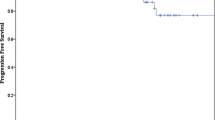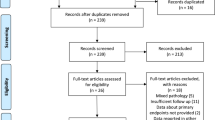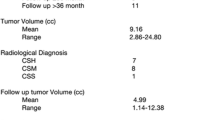Abstract
Purpose
Stereotactic radiosurgery (SRS) is an effective and less invasive therapeutic option for cavernous sinus (CS) tumors. However, its long-term effectiveness and neurological outcomes have yet to be fully elucidated. We aimed to examine the long-term outcomes of SRS for CS tumors.
Methods
Overall, a cohort of 113 patients with benign CS tumors, including 91 with meningioma, 14 with trigeminal schwannoma (TS), and eight with cavernous hemangioma, treated with SRS at our institution from 1990 to 2018, was included. Tumor control and functional preservation/recovery were evaluated in detail.
Results
The median post-SRS follow-up period was 77 months (interquartile range, 39–177). Progression-free survival (PFS) was 97% at 5 years, 89% at 10 years, and 87% at 15 years for the entire cohort; 96% at 5 years and 87% at 10 years for meningiomas; and 100% at 10 years for the other tumors. No significant difference was observed between meningiomas and non-meningiomas (log-rank test, p = 0.107). Improvement in cranial nerve (CN) function was observed in 35 (27%) patients. TSs tended to show CN improvements more often than meningiomas did (total improvements, 62% vs. 23%; p = 0.004; eye movement function, 100% vs. 20%; p = 0.002). CN deterioration or development of new CN deficits was observed in 11 (10%) patients.
Conclusion
SRS provides good tumor control and acceptable long-term outcome with sufficient preservation of CN function in patients with benign CS tumors.



Similar content being viewed by others
Data availability
The datasets generated during and/or analyzed during the current study are available from the corresponding author upon reasonable request.
References
McCormick PC, Bello JA, Post KD (1988) Trigeminal schwannoma. Surgical series of 14 cases with review of the literature. J Neurosurg 69:850–860. https://doi.org/10.3171/jns.1988.69.6.0850
Tagle P, Huete I, Méndez J, del Villar S (1986) Intracranial cavernous angioma: presentation and management. J Neurosurg 64:720–723. https://doi.org/10.3171/jns.1986.64.5.0720
Adegbite AB, Khan MI, Paine KW, Tan LK (1983) The recurrence of intracranial meningiomas after surgical treatment. J Neurosurg 58:51–56. https://doi.org/10.3171/jns.1983.58.1.0051
Rennert RC, Ravina K, Strickland BA, Bakhsheshian J, Fredrickson VL, Russin JJ (2018) Complete cavernous sinus resection: an analysis of complications. World Neurosurg 119:89–96. https://doi.org/10.1016/j.wneu.2018.07.206
Nanda A, Thakur JD, Sonig A, Missios S (2016) Microsurgical resectability, outcomes, and tumor control in meningiomas occupying the cavernous sinus. J Neurosurg 125:378–392. https://doi.org/10.3171/2015.3.JNS142494
O’Sullivan MG, van Loveren HR, Tew JM, Jr (1997) The surgical resectability of meningiomas of the cavernous sinus. Neurosurgery 40:238–244; discussion 245–237. https://doi.org/10.1097/00006123-199702000-00003
Tishler RB, Loeffler JS, Lunsford LD, Duma C, Alexander E 3rd, Kooy HM, Flickinger JC (1993) Tolerance of cranial nerves of the cavernous sinus to radiosurgery. Int J Radiat Oncol Biol Phys 27:215–221. https://doi.org/10.1016/0360-3016(93)90230-s
Leber KA, Berglöff J, Pendl G (1998) Dose–response tolerance of the visual pathways and cranial nerves of the cavernous sinus to stereotactic radiosurgery. J Neurosurg 88:43–50. https://doi.org/10.3171/jns.1998.88.1.0043
Liu AL, Wang C, Sun S, Wang M, Liu P (2005) Gamma knife radiosurgery for tumors involving the cavernous sinus. Stereotact Funct Neurosurg 83:45–51. https://doi.org/10.1159/000085544
Tripathi M, Batish A, Kumar N, Ahuja CK, Oinam AS, Kaur R, Narayanan R, Gurnaani J, Kaur A (2020) Safety and efficacy of single-fraction gamma knife radiosurgery for benign confined cavernous sinus tumors: our experience and literature review. Neurosurg Rev 43:27–40. https://doi.org/10.1007/s10143-018-0975-8
Starke RM, Williams BJ, Hiles C, Nguyen JH, Elsharkawy MY, Sheehan JP (2012) Gamma knife surgery for skull base meningiomas. J Neurosurg 116:588–597. https://doi.org/10.3171/2011.11.JNS11530
Huang CF, Kondziolka D, Flickinger JC, Lunsford LD (1999) Stereotactic radiosurgery for trigeminal schwannomas. Neurosurgery 45:11–16; discussion 16. https://doi.org/10.1097/00006123-199907000-00002
Sheehan J, Yen CP, Arkha Y, Schlesinger D, Steiner L (2007) Gamma Knife surgery for trigeminal schwannoma. J Neurosurg 106:839–845. https://doi.org/10.3171/jns.2007.106.5.839
Sun J, Zhang J, Yu X, Qi S, Du Y, Ni W, Hu Y, Tian Z (2013) Stereotactic radiosurgery for trigeminal schwannoma: a clinical retrospective study in 52 cases. Stereotact Funct Neurosurg 91:236–242. https://doi.org/10.1159/000345258
Ryu J, Lee SH, Choi SK, Lim YJ (2018) Gamma knife radiosurgery for trigeminal schwannoma: a 20-year experience with long-term treatment outcome. J Neurooncol 140:89–97. https://doi.org/10.1007/s11060-018-2934-1
Snyder MH, Shepard MJ, Chen CJ, Sheehan JP (2018) Stereotactic radiosurgery for trigeminal schwannomas: a 28-year single-center experience and review of the literature. World Neurosurg 119:e874–e881. https://doi.org/10.1016/j.wneu.2018.07.289
Pomeraniec IJ, Taylor DG, Cohen-Inbar O, Xu Z, Lee Vance M, Sheehan JP (2019) Radiation dose to neuroanatomical structures of pituitary adenomas and the effect of gamma knife radiosurgery on pituitary function. J Neurosurg 132:1499–1506. https://doi.org/10.3171/2019.1.JNS182296
Shin M, Kurita H, Sasaki T, Kawamoto S, Tago M, Kawahara N, Morita A, Ueki K, Kirino T (2001) Analysis of treatment outcome after stereotactic radiosurgery for cavernous sinus meningiomas. J Neurosurg 95:435–439. https://doi.org/10.3171/jns.2001.95.3.0435
Shinya Y, Hasegawa H, Shin M, Sugiyama T, Kawashima M, Takahashi W, Iwasaki S, Kashio A, Nakatomi H, Saito N (2019) Long-term outcomes of stereotactic radiosurgery for vestibular schwannoma associated with neurofibromatosis Type 2 in comparison to sporadic schwannoma. Cancers 11:1498. https://doi.org/10.3390/cancers11101498
Wen PY, Macdonald DR, Reardon DA, Cloughesy TF, Sorensen AG, Galanis E, Degroot J, Wick W, Gilbert MR, Lassman AB, Tsien C, Mikkelsen T, Wong ET, Chamberlain MC, Stupp R, Lamborn KR, Vogelbaum MA, van den Bent MJ, Chang SM (2010) Updated response assessment criteria for high-grade gliomas: response assessment in neuro-oncology working group. J Clin Oncol 28:1963–1972. https://doi.org/10.1200/JCO.2009.26.3541
Nagano O, Higuchi Y, Serizawa T, Ono J, Matsuda S, Yamakami I, Saeki N (2008) Transient expansion of vestibular schwannoma following stereotactic radiosurgery. J Neurosurg 109:811–816. https://doi.org/10.3171/JNS/2008/109/11/0811
Mindermann T, Schlegel I (2014) How to distinguish tumor growth from transient expansion of vestibular schwannomas following gamma knife radiosurgery. Acta Neurochir 156:1121–1123. https://doi.org/10.1007/s00701-014-2063-3
Kano H, Niranjan A, Kondziolka D, Flickinger JC, Dade Lunsford L (2009) Stereotactic radiosurgery for trigeminal schwannoma: tumor control and functional preservation Clinical article. J Neurosurg 110:553–558. https://doi.org/10.3171/2008.7.jns0812
Albano L, Losa M, Nadin F, Barzaghi LR, Parisi V, Del Vecchio A, Bolognesi A, Mortini P (2019) Safety and efficacy of multisession gamma knife radiosurgery for residual or recurrent pituitary adenomas. Endocrine 64:639–647. https://doi.org/10.1007/s12020-019-01876-2
Lee WJ, Cho KR, Choi JW, Kong DS, Seol HJ, Nam DH, Lee JI (2020) Gamma knife radiosurgery as a primary treatment for nonfunctioning pituitary adenoma invading the cavernous sinus. Stereotact Funct Neurosurg 98:371–377. https://doi.org/10.1159/000508737
Yu J, Li Y, Quan T, Li X, Peng C, Zeng J, Liang S, Huang M, He Y, Deng Y (2020) Initial gamma knife radiosurgery for nonfunctioning pituitary adenomas: results from a 26-year experience. Endocrine 68:399–410. https://doi.org/10.1007/s12020-020-02260-1
Lee CC, Sheehan JP, Kano H, Akpinar B, Martinez-Alvarez R, Martinez-Moreno N, Guo WY, Lunsford LD, Liu KD (2017) Gamma knife radiosurgery for hemangioma of the cavernous sinus. J Neurosurg 126:1498–1505. https://doi.org/10.3171/2016.4.JNS152097
Wang Y, Li P, Zhang XJ, Xu YY, Wang W (2016) Gamma knife surgery for cavernous sinus hemanginoma: A report of 32 cases. World Neurosurg 94:18–25. https://doi.org/10.1016/j.wneu.2016.06.094
Lee CC, Trifiletti DM, Sahgal A, DeSalles A, Fariselli L, Hayashi M, Levivier M, Ma L, Álvarez RM, Paddick I, Regis J, Ryu S, Slotman B, Sheehan J (2018) Stereotactic radiosurgery for benign (World Health Organization Grade I) cavernous sinus meningiomas-international stereotactic radiosurgery society (ISRS) practice guideline: a systematic review. Neurosurgery 83:1128–1142. https://doi.org/10.1093/neuros/nyy009
Nicolato A, Foroni R, Alessandrini F, Bricolo A, Gerosa M (2002) Radiosurgical treatment of cavernous sinus meningiomas: experience with 122 treated patients. Neurosurgery 51:1153–1159; discussion 1159–1161. https://doi.org/10.1097/00006123-200211000-00009
Maruyama K, Shin M, Kurita H, Kawahara N, Morita A, Kirino T (2004) Proposed treatment strategy for cavernous sinus meningiomas: a prospective study. Neurosurgery 55:1068–1075. https://doi.org/10.1227/01.neu.0000140839.47922.5a
Williams BJ, Yen CP, Starke RM, Basina B, Nguyen J, Rainey J, Sherman JH, Schlesinger D, Sheehan JP (2011) Gamma Knife surgery for parasellar meningiomas: long-term results including complications, predictive factors, and progression-free survival. J Neurosurg 114:1571–1577. https://doi.org/10.3171/2011.1.JNS091939
Zeiler FA, McDonald PJ, Kaufmann AM, Fewer D, Butler J, Schroeder G, West M (2012) Gamma Knife radiosurgery of cavernous sinus meningiomas: an institutional review. Can J Neurol Sci 39:757–762. https://doi.org/10.1017/s0317167100015572
Pollock BE, Stafford SL, Link MJ, Garces YI, Foote RL (2013) Single-fraction radiosurgery of benign cavernous sinus meningiomas. J Neurosurg 119:675–682. https://doi.org/10.3171/2013.5.JNS13206
Fariselli L, Biroli A, Signorelli A, Broggi M, Marchetti M, Biroli F (2016) The cavernous sinus meningiomas’ dilemma: surgery or stereotactic radiosurgery? Rep Pract Oncol Radiother 21:379–385. https://doi.org/10.1016/j.rpor.2015.05.002
Leroy HA, Tuleasca C, Reyns N, Levivier M (2018) Radiosurgery and fractionated radiotherapy for cavernous sinus meningioma: a systematic review and meta-analysis. Acta Neurochir 160:2367–2378. https://doi.org/10.1007/s00701-018-3711-9
Park KJ, Kano H, Iyer A, Liu X, Tonetti DA, Lehocky C, Faramand A, Niranjan A, Flickinger JC, Kondziolka D, Lunsford LD (2018) Gamma Knife stereotactic radiosurgery for cavernous sinus meningioma: long-term follow-up in 200 patients. J Neurosurg 130:1799–1808. https://doi.org/10.3171/2018.2.JNS172361
Hung YC, Lee CC, Guo WY, Shiau CY, Chang YC, Pan DH, Sheehan JP, Chung WY (2019) Gamma knife radiosurgery for the treatment of cavernous sinus meningiomas: post-treatment long-term clinical outcomes, complications, and volume changes. J Neurooncol 143:261–270. https://doi.org/10.1007/s11060-019-03090-6
Hafez RF, Morgan MS, Fahmy OM (2015) Stereotactic gamma knife surgery safety and efficacy in the management of symptomatic benign confined cavernous sinus meningioma. Acta Neurochir 157:1559–1564. https://doi.org/10.1007/s00701-015-2509-2
Kano H, Park KJ, Kondziolka D, Iyer A, Liu X, Tonetti D, Flickinger JC, Lunsford LD (2013) Does prior microsurgery improve or worsen the outcomes of stereotactic radiosurgery for cavernous sinus meningiomas? Neurosurgery 73:401–410. https://doi.org/10.1227/01.neu.0000431471.64289.3d
Sun S, Liu A, Zhang Y (2019) Long-term follow-up studies of gamma knife radiosurgery for postsurgical nonfunctioning pituitary adenomas. World Neurosurg 24:e715–e723. https://doi.org/10.1016/j.wneu.2019.01.009
Wang X, Zhu H, Knisely J, Mei G, Liu X, Dai J, Mao Y, Pan L, Qin Z, Wang E (2018) Hypofractionated stereotactic radiosurgery: a new treatment strategy for giant cavernous sinus hemangiomas. J Neurosurg 128:60–67. https://doi.org/10.3171/2016.10.JNS16693
Sughrue ME, Rutkowski MJ, Aranda D, Barani IJ, McDermott MW, Parsa AT (2010) Factors affecting outcome following treatment of patients with cavernous sinus meningiomas. J Neurosurg 113:1087–1092. https://doi.org/10.3171/2010.3.JNS091807
Graffeo CS, Link MJ, Stafford SL, Parney IF, Foote RL, Pollock BE (2020) Risk of internal carotid artery stenosis or occlusion after single-fraction radiosurgery for benign parasellar tumors. J Neurosurg 133:1388–1395. https://doi.org/10.3171/2019.8.JNS191285
Pikis S, Bunevicius A, Sheehan J (2021) Internal carotid artery stenosis and risk of cerebrovascular ischemia following stereotactic radiosurgery for recurrent or residual pituitary adenomas. Pituitary 24:574–581. https://doi.org/10.1007/s11102-021-01134-7
Acknowledgements
None
Funding
This work was supported by JSPS KAKENHI (Grant Number 19K24042 to Yuki Shinya).
Author information
Authors and Affiliations
Contributions
Conceptualization: MU and YS; Methodology: MU and YS; Formal analysis and investigation: MU and YS; Writing—original draft preparation: MU; Writing—review and editing: YS, HH, MS, MK, AK, and NS; Funding acquisition: YS; Resources: YS, HH, SM, MK, and AK; Supervision: MS and NS.
Corresponding author
Ethics declarations
Conflict of interest
The authors have no conflicts of interest to declare that are relevant to the content of this article.
Ethical approval
The study was approved by the Institutional Review Board of our institution (#2231) and performed in accordance with the ethical standards as laid down in the 1964 Declaration of Helsinki and its later amendments or comparable ethical standards.
Informed consent
All patients provided written informed consent for study participation.
Additional information
Publisher's Note
Springer Nature remains neutral with regard to jurisdictional claims in published maps and institutional affiliations.
Supplementary Information
Below is the link to the electronic supplementary material.
Rights and permissions
About this article
Cite this article
Umekawa, M., Shinya, Y., Hasegawa, H. et al. Long-term outcomes of stereotactic radiosurgery for skull base tumors involving the cavernous sinus. J Neurooncol 156, 377–386 (2022). https://doi.org/10.1007/s11060-021-03921-5
Received:
Accepted:
Published:
Issue Date:
DOI: https://doi.org/10.1007/s11060-021-03921-5




